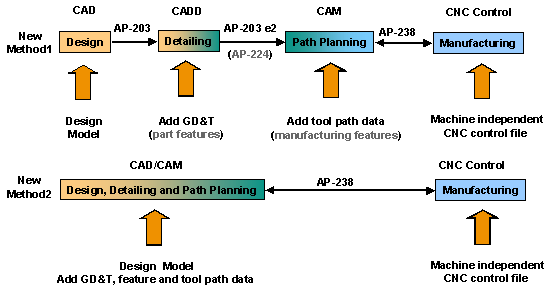Frequently Asked Questions
Questions about producing parts using STEP-NC
How do I use AP-238?
AP-238 is a replacement for RS274D. In large enterprises it also
replaces APT and BCL.
What is the current method for making parts on
CNC Controls?
Today, a customer details a drawing describing the part. The drawing
describes the geometry, the material, the dimensions and the
tolerances of the part. The drawing is sent to the job shop as IGES
and PDF files or on paper. The job shop uses a CAM to define a
manufacturing process that makes the part from the stock by removing
material. The CAM operator refers to the drawing to understand how to
implement the process. In some cases the IGES file contains geometric
entities such as surfaces that help the operator define the
process. When the process is built, the CAM system then translates it
into G-codes that tell a machine tool where to move a cutting
tool. The G-codes are sent to a CNC as a file in a vendor specific
flavor of the RS274D format.

And the new method on STEP-NC Controls?
In the new method, a customer makes an AP-203 file describing the part
geometry using a CAD system. The design requirements are then added as
GD&T data. The result is exported to a CAM system as an AP-203 edition
2 file or as an AP-224 file if the detailing also includes the
definition of part features. The CAM system is then used to determine
a manufacturing plan and this is exported to the CNC as an AP-238
file. The manufacturing plan can be exported as CNC independent tool
path data, or as manufacturing removal volume feature data or both.

How to make the AP-238 file?
There are two methods for making the AP-238 file. The first method
allows a detailer at either the customer or the job shop to define the
manufacturing features and tool paths. In the second method, the
enterprise creates a complete manufacturing data set using an
integrated CAD/CAM system and exports this data to the job shop as an
AP-238 file. In either case if all the parameters are not quite right
the job shop can read the file into its CAM system and adjust them
because, unlike the RS274D interface, the AP-238 interface is
bi-directional.
How will an operator use a STEP-NC control?
Like an automobile, putting more under the hood of a CNC controller
makes the controller easier and safer to use ... not
harder. Specifically, the many buttons and dials of a traditional
control can be reduced to three on a STEP-NC Controller: "Run" to make
the part; "Verify" to check for collisions without making the part;
and "Document" to generate documentation describing how the part has
been made or would be made on this machine tool at this time.
What about shops that do not have a
STEP-NC Control?
Until the new controls become widely available, job shops can read
AP-238 files into their CAM systems and use them to generate RS274D
codes for their machines.